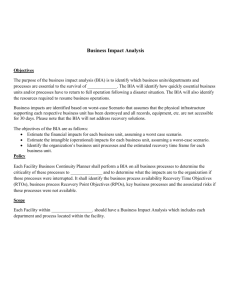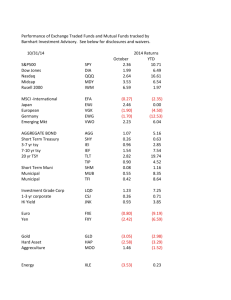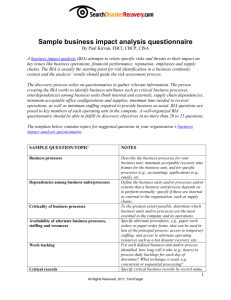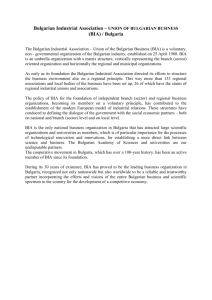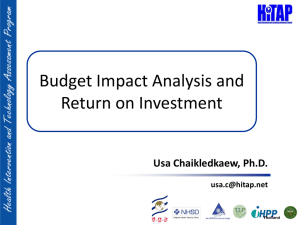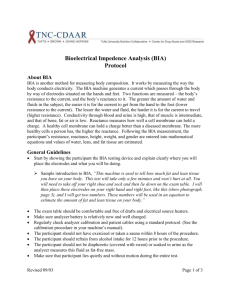The Business Impact Assessment Process
advertisement
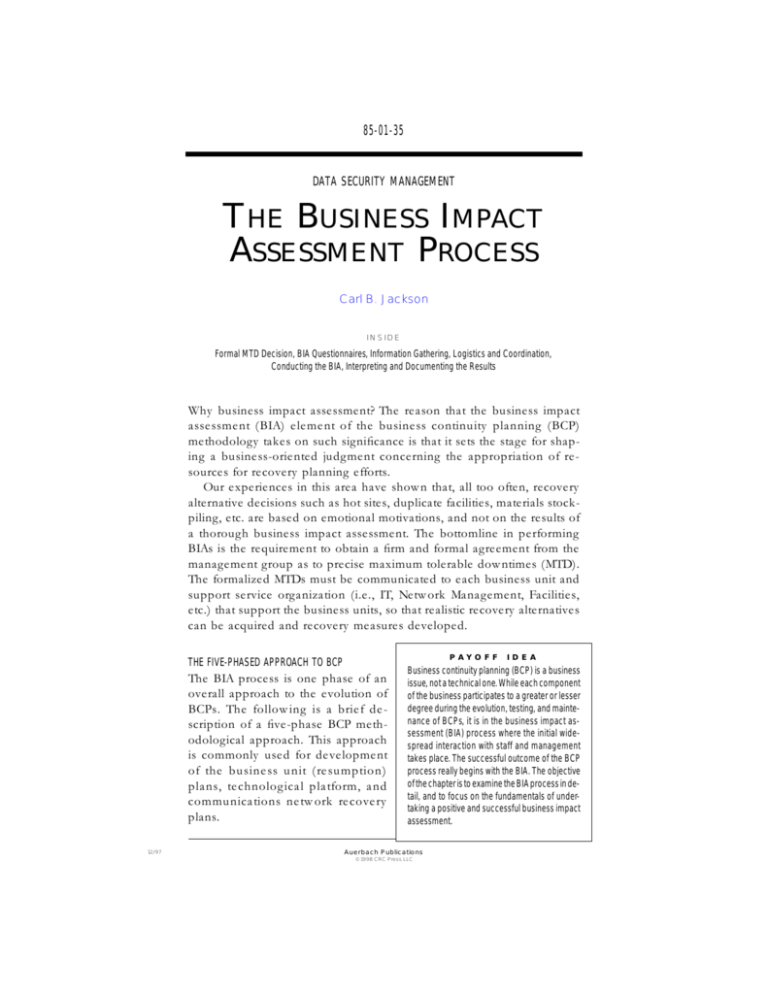
85-01-35 DATA SECURITY MANAGEMENT THE BUSINESS IMPACT ASSESSMENT PROCESS Carl B. Jackson INSIDE Formal MTD Decision, BIA Questionnaires, Information Gathering, Logistics and Coordination, Conducting the BIA, Interpreting and Documenting the Results Why business impact assessment? The reason that the business impact assessment (BIA) element of the business continuity planning (BCP) methodology takes on such significance is that it sets the stage for shaping a business-oriented judgment concerning the appropriation of resources for recovery planning efforts. Our experiences in this area have shown that, all too often, recovery alternative decisions such as hot sites, duplicate facilities, materials stockpiling, etc. are based on emotional motivations, and not on the results of a thorough business impact assessment. The bottomline in performing BIAs is the requirement to obtain a firm and formal agreement from the management group as to precise maximum tolerable downtimes (MTD). The formalized MTDs must be communicated to each business unit and support service organization (i.e., IT, Network Management, Facilities, etc.) that support the business units, so that realistic recovery alternatives can be acquired and recovery measures developed. PAYOFF THE FIVE-PHASED APPROACH TO BCP The BIA process is one phase of an overall approach to the evolution of BCPs. The following is a brief description of a five-phase BCP methodological approach. This approach is commonly used for development of the business unit (resumption) plans, technological platform, and communications network recovery plans. 12/97 IDEA Business continuity planning (BCP) is a business issue, not a technical one. While each component of the business participates to a greater or lesser degree during the evolution, testing, and maintenance of BCPs, it is in the business impact assessment (BIA) process where the initial widespread interaction with staff and management takes place. The successful outcome of the BCP process really begins with the BIA. The objective of the chapter is to examine the BIA process in detail, and to focus on the fundamentals of undertaking a positive and successful business impact assessment. Auerbach Publications © 1998 CRC Press LLC • Phase I: BCP Project Scoping and Planning — This phase includes an examination of the organization’s distinct business operations and information system support services in order to form a project plan to direct subsequent phases of the activity. Project planning activities involve defining the precise scope, organization, timing, staffing, and other issues so that the project status and requirements can be articulated throughout the organization, and chiefly to those departments and personnel who will be playing the most meaningful roles in the BCPs development. • Phase II: Business Impact Assessment — This phase involves developing a grasp of the proportion of impact individual business units would sustain subsequent to a significant interruption of computing and communication services. These impacts may be financial, in terms of dollar loss or impact, or operational in nature, such as the inability to deliver and monitor quality customer service, etc. • Phase III: Develop Recovery Strategy — The information collected in Phase II is employed to approximate the recovery resources (i.e., business unit or departmental space and resource requirements, and technological platform services and communications networks requirements) necessary to support time-critical business functions. During this phase, an appraisal of recovery alternatives and alternative cost-estimates are prepared and presented to management. • Phase IV: Recovery Plan Development — This phase includes the development of the actual business continuity or recovery plans themselves. Explicit documentation is required for execution of an effective recovery process and includes both administrative inventory information and detailed recovery team action plans, among other information. • Phase V: Implementation, Testing, and Maintenance — The final phase involves establishing a rigorous testing and maintenance management program as well as addressing the initial and ongoing testing and maintenance activities. BIA PROCESS DESCRIPTION As mentioned above, the intent of the BIA process is to assist the organization’s management in understanding the impacts associated with possible threats, and to employ that intelligence to calculate the maximum tolerable downtime for reliance upon time-critical support services and resources. For most organizations, time-critical support services and resources include: • Personnel • Facilities • Technological platforms (all computer systems) • • • • • Software Data networks and equipment Voice networks and equipment Vital records Data, etc. IMPORTANCE OF DOCUMENTING A FORMAL MTD DECISION The BIA process comes to a conclusion when the organization’s senior management group has considered the impacts to the business processes due to outages of vital support services and then makes a formalized decision on the MTD they are willing to live with. This includes a decision to communicate that MTD decision(s) to each business unit and support service manager involved. Why is it so important that a formalized decision be made? Because the failure to document and communicate precise MTD information leaves each manager with imprecise direction on (1) selection of an appropriate recovery alternative method; and (2) the depth of detail which will be required when developing recovery procedures, including their scope and content. We have seen many a well-executed BIA with excellent results be wasted because the senior management group failed to articulate their acceptance of the results and to communicate to each affected manager that the time requirements for recovery processes had been defined. USE OF BIA QUESTIONNAIRES There is no question that the people-to-people contact of the BIA process is the most important component in understanding the potential a disaster will have upon an organization. People run the organization, and can best describe business functionality and their business unit’s degree of reliance on support services. The issue here, however, is deciding what is the best and most practical technique for gathering the information from these people. There are different schools of thought about the use of questionnaires during the BIA process. Our opinion is that a well-crafted questionnaire will provide the structure needed by the BCP project team to consistently acquire the required information. This consistent questioning structure requires that the same questions be asked of each BIA interviewee — reliance can be placed on the results because answers to questions can be compared one to another, and the comparisons are based on the same criterion. While we consider a questionnaire to be a valuable tool, the structure of the questions in the questionnaire itself is subject to a great deal of customization. This customization of the questions depends largely upon the reason why the BIA is being conducted in the first place. The BIA process can be approached differently depending upon the needs of the organization. Each BIA situation should be evaluated in order to understand the underlying purpose to properly design the scope and approach of the BIA process. BIAs may be desired for several reasons, including: • Initiation of a BCP process where no BIA has been done before as part of the five-phase BCP methodology (Phase 2). • Reinitiating a BCP process where there was a BIA performed but now it needs to be brought up to date. • Conducting a BIA in order to justify BCP activities which have already been undertaken (i.e., the acquisition of a hot site or other recovery alternative). • Simply updating the results of a previous BIA effort to identify changes in the environment and as a basis to plan additional activities. • Initiating a BIA as a prelude to considering the beginning of a full BCP process for understanding or as a vehicle to sell management on the need to develop a BCP. BIA INFORMATION-GATHERING TECHNIQUES There are various schools of thought regarding how to best gather BIA impact information. Conducting individual one-on-one BIA interviews is popular, but organizational size and location issues sometimes make conducting one-on-one interviews impossible. Other popular techniques include group exercises and/or the use of an electronic medium (i.e., data or voice network) or a combination of all of these. The following points highlight the pros and cons of these interviewing techniques: One-on-one BIA interviews — The one-on-one interview with organizational representatives is the preferred manner in which to gather the BIA impact information, in our opinion. The pros of this are that you have the ability to discuss the issues face-to-face and observe the person. This one-on-one discussion will give the interviewer a great deal of both verbal and visual information concerning the topic at hand. In addition, personal rapport can be built between the interviewee and the BIA team, with the potential for additional assistance and support to follow. This rapport can be very beneficial during later stages of the BCP development effort if the persons being interviewed understand that the BCP process was undertaken to help them get the job done in times of emergency or disaster. The minus to this approach is that it can become very time consuming and tends to stretch the length of the BIA process. Group BIA interview sessions or exercises — This type of information-gathering activity can be very efficient in ensuring that a lot of data are gathered in a short period of time and can speed the BIA process tremendously. The problem with this type of an approach, if not conducted properly, is it can result in a meeting of many people without much useful information being accurately recorded for later consideration. Electronic media — Especially these days, the use of voice, data, video conferencing, etc., media are popular. Many times, the physical size and diversity as well as the structural complexity of the organization lends itself to this clean information-gathering technique. The pros are that distances can be diminished and travel expenses reduced, and that the use of automated questionnaires and other data-gathering methods can facilitate the capture of tabular data and make the ease of consolidation of this information possible. Less attractive, however, is that this type of communication lacks the human touch, and sometimes ignores the importance of the ability of the interviewer to read the verbal and visual communications of the interviewee. Especially worrisome, however, is the universal broadcasting of BIA-related questionnaires. These inquiries go to an uninformed or little informed group of users on a network, whereby they are asked to supply answers to qualitative and quantitative BIA questions without regard to the point of the question or the intent of the use of the result. Such practices almost always lend themselves to misleading and downright wrong results. This type of unsupported datagathering technique for purposes of formulating a thoughtful strategy for recovery should be avoided. Most likely, however, your organization will need to use a mix of these suggested methods, or use others suited to the situation and culture of the enterprise. CUSTOMIZING THE BIA QUESTIONNAIRE There are a number of ways in which a BIA questionnaire can be constructed and/or customized to adapt itself for the purpose of serving as an efficient tool for accurately gathering BIA information. There are also an unlimited number of examples of BIA questionnaires in use by organizations. It should go without saying that any questionnaire, BIA or otherwise, can be constructed so as to elicit the response one would like to derive. It is important that the goal of the BIA be in the mind of the questionnaire developers so that the questions asked and the responses collected will meet the objective of the BIA process. BIA QUESTIONNAIRE CONSTRUCTION Exhibit 1 features an example of a BIA questionnaire. Basically, the BIA questionnaire is made up of the following types of questions: • Quantitative Questions — These are the questions the interviewee is asked to consider to describe the economic or financial impacts of a potential disruption. Measured in monetary terms, an estimation of these impacts will aid the organization in understanding loss poten- tial, in terms of lost income as well as in an increase in extraordinary expense. The typical qualitative impact categories might include: revenue or sales loss, lost trade discounts, interest paid on borrowed money, interest lost on float, penalties for late payment to vendors or lost discounts, contractual fines or penalties, unavailability of funds, canceled orders due to late delivery, etc. Extraordinary expense categories might include: acquisition of outside services, temporary employees, emergency purchases, rental/lease equipment, wages paid to idle staff, and temporary relocation of employees. • Qualitative Questions — While the economic impacts can be stated in terms of dollar loss, the qualitative questions ask the participants to estimate potential loss impact in terms of their emotional understanding or feelings. It is surprising how often the qualitative measurements are used to put forth a convincing argument for a shorter recovery window. The typical qualitative impact categories might include loss of customer services capability, loss of confidence, etc. • Specialized Questions — Make sure that the questionnaire is customized to the organization. It is especially important to make sure that both the economic and operational impact categories (lost sales, interest paid on borrowed funds, business interruption, customer inconvenience, etc.) are stated in such a way that each interviewee will understand the intent of the measurement. Simple is better here. Using an automated tool? If an automated tool is being used to collect and correlate the BIA interview information, then make sure that the questions in the database and questions on the questionnaire are synchronized to avoid duplication of effort or going back to interviewees with questions that might have been handled initially. A word of warning here, however. we have seen people pick up a BIA questionnaire off the Internet or from a book or periodical (like this one) and use it without regard to the culture and practices of their own organization. Never, ever, use a noncustomized BIA questionnaire. The qualitative and quantitative questions must be structured to the environment and style of the organization. There is opportunity for failure should this point be dismissed. BIA INTERVIEW LOGISTICS AND COORDINATION This portion of the report will address the logistics and coordination while performing the BIA interviews themselves. Having scoped the BIA process, the next step is to determine who and how many people you are going to interview. In order to do this, there are some techniques you might use: • Use Organizational Charts to Compile Lists of Interviewees — You certainly are not going to interview everyone in the organization. You must select a sample of those management and staff personnel EXHIBIT 1 — Sample BIA Questionnaire Introduction • Business Unit Name: • Date of Interview: • Contact Name(s): • Identification of business unit (BU) function: • Briefly describe the overall business functions of the BU (with focus on time-critical functions/processes, and link each time-critical function/process to the IT application/network, etc.) and understand the business process and the systems/applications interrelationships Financial Impacts • Revenue Loss Impact Estimations (revenue or sales loss, lost trade discounts, interest paid on borrowed money, interest lost on float, penalties for late payment to vendors or lost discounts, contractual fines or penalties, unavailability of funds, canceled orders due to late delivery, etc.) • Extraordinary Expense Impact Estimations (acquisition of outside services, temporary employees, emergency purchases, rental/lease equipment, wages paid to idle staff, temporary relocation of employees, etc.) Operational Impacts • Business Interruption Impact Estimations (loss of customer service capabilities, inability to serve internal customers/management, etc.) • Loss of Confidence Estimations (loss of confidence on behalf of customers, shareholders, regulatory agencies, employees, etc.) Technological Dependence • Systems/Business Functions/Applications Reliance Description (attempt to identify specific automated systems/processes/applications that support BU operations) • Systems Interdependencies Descriptions • State of existing BCP measures • Other BIA-Related Discussion Issues who will provide you with the best information in the shortest period. In order to do that, you must have a precise feel for the scope of the project (i.e., technological platform recovery, business unit recovery, communications recovery, etc.) and with that understanding you can use: 1. Organizational Chart Reviews — The use of formal, or sometimes even informal organization charts is the first place to start. This method includes examining the organizational chart of the enterprise to understand those functional positions that should be included. Review the organizational chart to determine which organizational structures will be directly involved in the overall effort and those that will be the recipients of the benefits of the finished recovery plan. 2. Overlaying Systems Technology — Overlay systems technology (applications, networks, etc.) configuration information over the organization chart to understand the components of the organization that may be affected by an outage of the systems. Mapping applications, systems, and networks to the organization’s business • • • • • functions will aid tremendously when attempting to identify the appropriate names and numbers of people to interview. 3. Interview Technique — This method includes conducting introductory interviews of selected senior management representatives in order to identify critical personnel to be included in the BIA interview process. Coordinate with the IT Group If the scope of the BIA process is recovery of technological platforms and/or communications systems, then conducting interviews with a number of IT personnel could help shorten the data-gathering effort. While IT users can often provide much valuable information, they should not be relied upon solely as the primary source of business impact outage information (i.e., revenue loss, extra expense, etc.). Send Questionnaire out in Advance — It is a useful technique to distribute the questionnaire to the interviewees in advance. Whether it is in hard copy or electronic media format, the person being interviewed should have a chance to review the questions, be able to invite others into the interview or redirect the interview to others, and begin to develop the responses. You should emphasize to the people who receive the questionnaire in advance to not fill it out, but to simply review it and be prepared to address the questions. Schedule One-Hour Interviews — Ideally, the BIA interview should last between 45 and 75 minutes. We have found that it sometimes can be advantageous to go longer than this, but if you see many of the interviews lasting longer than the 75-minute window, then there may be a BIA scoping issue which should be addressed, necessitating the need to schedule and conduct a larger number of additional interviews. Limit Number of Interviewees — It is important to limit the number of interviewees in the session to one, two, or three, but no more. Given the amount and quality of information you are hoping to elicit from this group, more than three people can deliver a tremendous amount of good information that can be missed when too many people are delivering the message at the same time. Try to Schedule Two Interviewers — When setting up the BIA interview schedule, try to ensure that at least two interviewers can attend and take notes. This will help eliminate the possibility that good information may be missed. Every additional trip back to an interviewee for confirmation of details will add overhead to the process. CONDUCTING THE BIA When actually explaining the intent of the BIA to those being interviewed, the following concepts should be observed and perhaps discussed with the participants: • Intelligent Questions Asked of Knowledgeable People — Based loosely on the concept that if you ask enough reasonably intelligent people a consistent set of measurable questions, you will eventually reach a conclusion which is more or less the correct one. The BIA questions serve to elicit qualitative results from a number of knowledgeable people. The precise number of people interviewed obviously depends on the scope of the BCP activity and the size of the organization. However, when consistently directing a well-developed number of questions to an informed audience, the results will reflect a high degree of reliability. This is the point when conducting qualitatively oriented BIA — ask the right people good questions, and you will come up with the right results! • Ask to Be Directed to the Correct People — As the interview unfolds, it may become evident that the interviewee is the wrong person to be answering the questions. You should ask who else within this area would be better suited to address these issues. They might be invited into the room at that point, or you may want to schedule a meeting with them at another time. • Assure Them That Their Contribution Is Valuable — A very important way for you to build the esteem of the interviewee is to mention that their input to this process is considered valuable, as it will be used to formulate strategies necessary to recover the organization following a disruption or disaster. Explaining to them that you are there to help by getting their business unit’s relevant information for input to planning a recovery strategy can sometimes change the tone of the interview positively. • Explain That the Plan Is Not Strictly an IT Plan — Even if the purpose of the BIA is for IT recovery, when interviewing business unit management for the process of preparing a technological platform recovery plan, it is sometimes useful to couch the discussion in terms of … “a good IT recovery plan, while helping IT recover, is really a business unit plan.” Why? Because the IT plan will recover the business functionality of the interviewees business unit as well, and that is why you are there. • Focus on Who Will Really Be Exercising the Plan — Another technique is to mention that the recovery plan that will eventually be developed can be used by the interviewees, but is not necessarily developed for them. Why? Because the people that you are talking to probably already understand what to do following a disaster, without referring to extensive written recovery procedures. But the fact of the matter is that following the disruption, these people may not be available. It may well be the responsibility of the next generation of management to recover, and it will be the issues identified by this interviewee that will serve as the recovery road map. • Focus on Time-Critical Business Functions or Processes — As the BIA interview progresses, it is sometimes important to fall back from time to time and reinforce the concept that we are interested in the identification of time-critical functions and processes. • Assume Worst-Case Disaster — When faced with the question as to “When will the disruption occur?” The answer should be, “It will occur at the worst possible time for your business unit. If you close your books on 12/31, and you need the computer system the most on 12/30 and 12/31, the disaster will occur on 12/29.” Only when measuring the impacts of a disruption at the worst time can the interviewer get an idea as to the full impact of the disaster, and ensure that the impact information can be meaningfully compared from one business unit to the next. • Assume No Recovery Capability Exists — In order to reach results which are comparable, it is essential that you insist that the interviewees assume that no recovery capability will exist as they answer the impact questions. The reason for this is that when they attempt to quantify and/or qualify the impact potential, they may confuse a preexisting recovery plan or capability with no impact, and that is incorrect. No matter the existing recovery capability, the impact of a loss of services must be measured in raw terms so that as you compare the results of the interviews from business unit to business unit, the results are comparable (apples to apples, if you will). • Order of Magnitude Numbers and Estimates — The financial impact information is needed in orders of magnitude estimates only. Do not get bogged down in minutiae as it is easy to get lost in the detail. The BIA process is not a quantitative risk assessment! It is not meant to be. It is qualitative in nature and, as such, orders of magnitude impacts are completely appropriate and even desirable. Why? Because preciseness in estimation of loss impact almost always will result in arguments about the numbers. When this occurs, the true goal of the BIA is lost, because it turns the discussion into a numbers game, not a balanced discussion concerning financial and operational impact potentials. Because of the unlimited and unknown varieties of disasters that could possibly befall an organization, the true numbers can never ever be precisely known, at least until after the disaster. The financial impact numbers are merely estimates intended to illustrate degrees of impacts. So skip the numbers exercise and get to the point. • Stay Focused on the BCP Scope — Whether the BIA process is for development of technological platforms, end-user, facilities recovery, voice network, etc., it is very important that you do not allow scope creep in the minds of the interviewees. The discussion can become very unwieldy if you do not hold the focus of the loss impact discussions on the precise scope of the BCP project. • There Are No Wrong Answers — Because all the results will be compared with one-another before the BIA report is forwarded, then you can emphasize that the interviewee should not worry about wrong answers. As the BIA process evolves, each business units financial and operational impacts will be compared with the others, and those impact estimates which are out of line with the rest will be challenged and adjusted accordingly. • Do Not Insist upon Getting the Financial Information on the Spot — Sometimes the compilation of financial loss impact information requires a little time to accomplish. We often will tell the interviewee that we will return within a few days to collect the information, so that additional care can be taken in preparation — making sure that we do actually return and pick up the information later. • The Value of Push Back — Do not underestimate the value of push back when conducting BIA interviews. Business unit personnel will, most times, tend to view their activities as extremely time-critical, with little or no downtime acceptable. In reality, their operations will be arranged in some priority order with the other business processes of the organization for recovery priority. Realistic MTDs must be reached, and sometimes the interviewer must push back and challenge what may be considered unrealistic recovery requirements. Be realistic in challenging, and request that the interviewees be realistic in estimating their business units MTDs. Common ground will eventually be found that will be more meaningful to those who will read the BIA Findings and Recommendations Report — the senior management group. Interpreting and Documenting the Results As the BIA interview information is gathered, there is considerable tabular and written information that begins to quickly accumulate. This information must be correlated and analyzed. Many issues will arise here and there will be issues and some follow-up interviews or information-gathering requirements. The focus at this point in the BIA process should be as follows: • Begin Documentation of the Results Immediately — Even as the initial BIA interviews are being scheduled and completed, it is a good idea to begin preparation of the BIA Findings and Recommendations Report and actually start entering preliminary information. The reason is twofold. The first is that if you wait to the end of the process to start formally documenting the results, it is going to be more difficult to recall details that should be included. Second, as the report begins to evolve, there will be issues that arise where you will want • • • • • • to perform additional investigation while you still have time to ensure the investigation can be thoroughly performed. Develop Individual Business Unit BIA Summary Sheets — Another practical technique is to document each and every BIA interview with its own BIA Summary Sheet. This information can eventually be used directly by importing it into the BIA Findings and Recommendations Report which can also be distributed back to each particular interviewee to authenticate the results of the interview. The BIA Summary Sheet contains a summation of all the verbal information that was documented during the interview. This information will be of great value later as the BIA process evolves. Send Early Results Back to Interviewees for Confirmation — By returning the BIA Summary Sheet for each of the interviews back to the interviewee, you can continue to build consensus for the BCP project and start to ensure that any future misunderstandings regarding the results can be avoided. Sometimes you may want to get a formal sign-off, and other times the process is simply informal. We Are Not Trying to Surprise Anyone! — The purpose for diligently pursuing the formalization of the BIA interviews and returning to confirm the understandings from the interview process is to make very sure that there are no surprises later. This is especially important in large BCP projects where the BIA process takes a substantial amount of time and there is always a possibility that someone might forget what was said. Definition of Time-Critical Business Functions/Processes — As has been emphasized in this chapter, all issues should focus back to the true time-critical business processes of the organization. Allowing attention to be shifted to specific recovery scenarios too early in the BIA phase will result in confusion and lack of attention toward what is really important. Tabulation of Financial Impact Information — There can be a tremendous amount of tabular information generated through the BIA process. It should be boiled down to its essence and presented in such a way as to support the eventual conclusions of the BIA project team. It is easy to overdo it with numbers. Just ensure that the numbers do not overwhelm the reader and fairly represent the impacts. Understanding the Implications of the Operational Impact Information — Oftentimes, the weight of evidence and the basis for the recovery alternative decision is based on the operational rather than the financial information. Why? Usually the financial impacts are more difficult to accurately quantify because the precise disaster situation and the recovery circumstances are hard to visualize. We know that there will be a customer service impact because of a fire, for instance. But we would have a hard time telling you with any de- gree of confidence what the revenue loss impact would be for a fire that affects one particular location of the organization. Since the BIA process should provide a qualitative estimate (orders of magnitude), the basis for making the hard decisions regarding acquisition of recovery resources are, in many cases, based on the operational impact estimates rather than hard financial impact information. Preparing the Management Presentation Presentation of the results of the BIA to concerned management should result in no surprises for them. If you are careful to ensure that the BIA findings are communicated and adjusted as the process has unfolded, then the management review process should really become more of a formality in most cases. The final presentation meeting with the senior management group is not the time to surface new issues and make startling results public for the first time. In order to achieve the best results in the management presentation, the following suggestions are offered: • Draft Report for Review Internally First — Begin drafting the report following the initial interviews. By doing this, you will be capturing fresh information. This information will be used to build the tables, graphs, and other visual demonstrations of the results, and it will be used to record the interpretations of the results in the verbiage of the final BIA Findings and Recommendation Report. One method for accomplishing a well-constructed BIA Findings and Recommendation Report from the very beginning is to record, at the completion of each interview, the tabular information into the BIA database or manual filing system in use to record this information. Second, the verbal information should be transcribed into a BIA Summary Sheet for each interview. This BIA Summary Sheet should be completed for each interviewee and contain the highlights of the interview in summarized form. As the BIA process continues, the BIA tabular information and the transcribed verbal information can be combined into the draft BIA Findings and Recommendations Report. The table of contents for a BIA Report may look like the following: • Schedule Individual Senior Management Meetings as Necessary — As you near the time for the final BIA presentation, it is sometimes a good idea to conduct a series of one-on-one meetings with selected senior management representatives in order to brief them on the results and gather feedback for inclusion in the final deliverables. In addition, this is a good time to begin building grassroots support for the final recommendations that will come out of the BIA process and concurrently give you an opportunity to practice making your points and discussing the pros and cons of the recommendations. EXHIBIT 2 — BIA Report Table of Contents 1. 2. 3. 4. 5. 6. 7. 8. 9. 10. 11. Executive Summary Background Current State Assessment Threats and Vulnerabilities Time-Critical Business Functions Business Impacts (Operational) Business Impacts (Financial) Recovery Approach Next Steps/Recommendations Conclusion Appendices (as needed) • Prepare Senior Management Presentation (Bullet Point) — Our experience says that senior management level presentations, most often, are better prepared in a brief and focused manner. It will undoubtedly become necessary to present much of the background information used to make the decisions and recommendations, but the formal presentation should be in bullet point format, crisp, and to the point. Of course every organization has its own culture, so be sure to understand and comply with the traditional means of making presentations within your own environment. Copies of the report, which have been thoroughly reviewed, corrected, bound, and bundled for delivery can be distributed at the beginning or the end of the presentation depending upon circumstances. In addition, copies of the bullet point handouts can also be supplied so attendees can make notes for reference at a later time. Remember, the BIA process should end with a formalized agreement as to managements intentions with regard to MTDs, so that business unit and support services managers can be guided accordingly. It is here that that formalized agreement should be discussed and the mechanism for acquiring and communicating it determined. • Distribute Report — Once the management team has had an opportunity to review the contents of the BIA Report and have made appropriate decisions and/or given other input, the final report should be distributed within the organization to the appropriate interested individuals. NEXT STEPS The BIA is completed when formalized senior management decisions have been made regarding (1) MTDs, (2) priorities for business unit and support services recovery, and (3) recovery resource funding sources. The next step is the determination of the most effective recovery alternative to be selected. The work gets a little easier here. We know what our recovery windows are, and we understand what our recovery priorities are. We now have to investigate and select recovery alternative solutions that fit the recovery window and recovery priorities expectations of the organization. Once the alternatives have been agreed upon, the actual recovery plans can be developed and tested, with organization personnel organized and trained to execute the recovery plans, when needed. SUMMARY The process of business continuity planning has matured substantially since the 1980s. No longer is BCP viewed as just a technological question. A practical and cost-effective approach toward planning for disruptions or disasters begins with the business impact assessment. Exhibit 3 depicts the BIA Route Map — a visual presentation of the process. The goal of the BIA is to assist the management group in identification of time-critical processes, and in recognizing their degree of reliance upon support services (i.e., IT, voice and data networks, facilities, HR, etc.). Time-critical business processes are prioritized in terms of their maximum tolerable downtime, so that senior management can make reasonable decisions as to the recovery costs and time frames that they are willing to fund and support. This article has focused on how organizations can facilitate the BIA process. Understanding and applying the various methods and techniques for gathering the BIA impact information will be the key to success. Only when senior management formalizes their decisions regarding recovery time frames and priorities can each business unit and support service manager formulate acceptable and efficient plans for recovery of operations in the event of disruption or disaster. It is for this reason that the BIA process is so important when developing efficient and cost-effective business continuity plans. EXHIBIT 3 EXHIBIT 4 — BIA Dos Checklist To-do’s when doing business impact assessments: • • • • • • • • Customize the BIA questionnaire Focus on time-critical business functions/processes Assume worst-case disaster Assume no recovery capability exists Obtain raw numbers in orders of magnitude Return for financial information (don’t wait for it during the interview) Go back and affirm that these same people agree with the output Get a formalized decision from senior management so that precise plans can be made by lower-level managers (MTD time frames, scope and depth of recovery procedures, etc.) Conducting the Interview: • When interviewing BU personnel, explain that you are here to get the information you need to help IT build their recovery plan. But the IT recovery plan is really for the business units. We are obtaining BU input as an aid in ensuring that IT constructs the proper recovery planning strategy. • Interviews last 45 minutes and no longer than 1 hour and 15 minutes. • The number of interviewees at one session should be at best one, and at worst three. More than that and the ability of the interviewer to take notes is questionable. • If possible, at least two personnel should be in attendance at the interview. Each should have a blank copy of the questionnaire on which to take notes. • One person should probably not perform more than four interviews per day. This is due to the need to successfully document the results of each interview as soon as possible and because of fatigue factors. • Never become confrontational with the interviewees. There is no reason that an interviewee should be made defensive in their answers to you unless they do not properly understand the purpose of the BIA interview. • Relate to the interviewees that their comments will be taken into consideration and documented with the others, and that they will be requested to review, at a later date, the output from the process for accuracy and to provide their concurrence. Carl B. Jackson is a principal and the National Service Leader for Business Continuity Planning for Ernst & Young LLP, in Houston, TX.
